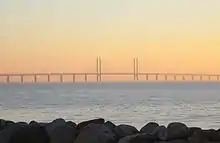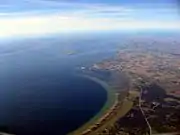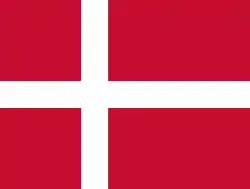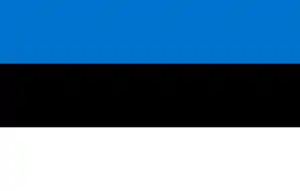European route E20
European route E20 is a part of the United Nations International E-road network. It runs roughly west–east through Ireland, the United Kingdom, Denmark, Sweden, Estonia, and Russia.
| |
|---|---|
 | |
| Major junctions | |
| West end | Shannon Airport, Ireland |
| East end | Saint Petersburg, Russia |
| Location | |
| Countries | |
| Highway system | |
| International E-road network
| |
Its length is 1,880 km (1,170 mi) but it is not continuous; at three points, a sea crossing is required. Roll-on/roll-off ferries make the crossings from Dublin to Liverpool and from Stockholm to Tallinn. No publicly accessible ferries traverse the North Sea from Kingston-upon-Hull to Esbjerg (as of 2019), but a ferry for commercial drivers leaves Immingham for Esbjerg on most days.[1]
Route
Ireland
The initial section of the E20 from Shannon Airport to Dublin via Limerick is approximately 228 km long and is only partially signed, along the M7/N7. The section from Shannon Airport to east of Limerick is mainly dual carriageway, with a short section of motorway as part of the Limerick Southern Ring Road. The Shannon Tunnel, opened on 16 July 2010, completed the bypass of Limerick. The section from Limerick to Naas is motorway (M7), and the final section from Naas to Dublin is dual carriageway (N7). A ferry must be used from Dublin to Liverpool.[2]
United Kingdom
E20 follows the A5080 from Liverpool to Huyton, the M62 from Huyton to South Cave, and the A63 from South Cave to Kingston upon Hull. The route length across the UK is 205 kilometres (127 mi) in total but is not signposted.
There are no ferries between Kingston upon Hull and Esbjerg. Alternative ferries were once available from Immingham, which is 48 kilometres (30 mi) from Kingston upon Hull, and Harwich, which is 350 kilometres (220 mi) from Kingston upon Hull. There are no longer any passenger routes operating between the UK and Scandinavia.
The closest alternative is to take the Eurotunnel Shuttle from Cheriton (Folkestone) to Calais, or take a ferry from Harwich to Hook of Holland. Both of these routes would require a detour of around 900 miles (940 miles to Esbjerg, as this route would require you to drive along the E20 to reach Esbjerg).[3]
Denmark
In Denmark, E20 is a motorway from Esbjerg to the Øresund Bridge. The length of the Danish part is 315 km (196 mi).
It passes first along Jutland from Esbjerg to Kolding, then crosses the Little Belt Bridge onto Funen. E20 crosses the entirety of Funen, passing around 2km from Odense. Then, at Nyborg, E20 crosses the Great Belt Fixed Link onto Zealand. E20 follows the Vestmotorvejen until Køge, where it goes north to Copenhagen. In Copenhagen, E20 passes south of the city, crossing onto Kastrup where it meets the Copenhagen Airport. The Øresund Bridge begins as a tunnel on Kastrup.
Between Køge and Copenhagen, the road has three E-road numbers (E47 and E55).
The Great Belt Bridge and Øresund Bridge are both tolled, charging over €30 each.[4][5] The road crosses the border between Denmark and Sweden on the Øresund Bridge.
Sweden
In Sweden, E20 is a motorway from the Öresund Bridge in Malmö to Nääs 30 km east of Gothenburg, a 320 km (200 mi) long motorway. Furthermore, it is a motorway most of the route from Vretstorp (20 km (12 mi) west of Örebro) to Stockholm.
The Swedish part of E20 is 770 km (480 mi) long. Its extent is shared with E6 along a 280 km (170 mi) long stretch, with E18 along 50 km (31 mi) and with E4 along 35 km (22 mi).
The part through Stockholm has very heavy traffic, including the most heavily trafficked road in Scandinavia, Essingeleden (160 000 vehicles/day). There is often congestion on this stretch. A new tunnel for route E20, "Norra länken", was built north of the city center and opened 30 November 2014.[6] The planned Förbifart Stockholm bypass will divert traffic from Essingeleden.
Between Stockholm and Tallinn a car ferry departs daily, taking 15 hours. The port in Stockholm is located at Lilla Värtan, about 4 km northeast of the central core of the city.
Estonia
In Estonia, E20 follows the route of national main road nr. 1 (Tallinn–Narva). In Tallinn to relieve traffic a bridge has been built on the intersection of the E263 and the E20. The E20 across Estonia is partially an unsigned expressway (speed limit 110 km/h in summer), for 80.7 km east of Tallinn to Aaspere along with a section near Haljala (km 87 - 90.5) and a section between Kohtla-Järve and Jõhvi (km 155.9–163.2). The remainder being single carriageway. The distance from Tallinn to the Russian border at the Narva River is 218 km.
Russia
In Russia, the route takes the Narva Highway (also listed in the Russian road numbering system as the A180 route, formerly known as the M11 route) running from Ivangorod to Saint Petersburg as a dual-lane highway. The distance from Ivangorod to Saint Petersburg is 142 km.
The border control facilities at the Estonia-Russia crossing are equipped and being operated for a limited amount of traffic on both sides of the border. The border crossing requires a reservation - despite this, waiting lines still can extend for many hours and even days.[7]
- E20 route, west to east
 The M62 passes Scammonden Reservoir in West Yorkshire
The M62 passes Scammonden Reservoir in West Yorkshire
 E20 next to the Copenhagen Airport
E20 next to the Copenhagen Airport
 On Oresund Bridge
On Oresund Bridge
 Near Jägala, Estonia
Near Jägala, Estonia
Itinerary
 Ireland
Ireland
- Gap (Irish Sea)
 United Kingdom
United Kingdom
 A5036: Bootle
A5036: Bootle M57: Liverpool Outer Ring Road (Whole length)
M57: Liverpool Outer Ring Road (Whole length) M62: Huyton - Manchester (Interchange with
M62: Huyton - Manchester (Interchange with  E5 and start of multiplex with
E5 and start of multiplex with  E22 at
E22 at  Warrington)
Warrington) M60: Manchester Outer Ring Road (Clockwise)
M60: Manchester Outer Ring Road (Clockwise) M62: Manchester -
M62: Manchester -  (Interchange with
(Interchange with  E15 at
E15 at .svg.png.webp) Pontefract and end of multiplex with
Pontefract and end of multiplex with  E22 at
E22 at  Goole)
Goole) A63:
A63:  - Hull
- Hull A1033: Hull
A1033: Hull
- Gap (North Sea)
 Denmark
Denmark
 Sweden
Sweden
.svg.png.webp) E20: Malmö (
E20: Malmö (.svg.png.webp)
.svg.png.webp) E22 / E65, Start of Concurrency with
E22 / E65, Start of Concurrency with .svg.png.webp) E6) - Helsingborg (
E6) - Helsingborg (.svg.png.webp) E4) - Gothenburg (
E4) - Gothenburg (.svg.png.webp) E45, End of Concurrency with
E45, End of Concurrency with .svg.png.webp) E6) - Örebro (Start of Concurrency with
E6) - Örebro (Start of Concurrency with .svg.png.webp) E18) - Arboga (End of Concurrency with
E18) - Arboga (End of Concurrency with .svg.png.webp) E18) - Eskilstuna - Södertälje (Start of Concurrency with
E18) - Eskilstuna - Södertälje (Start of Concurrency with .svg.png.webp) E4) - Stockholm (End of Concurrency with
E4) - Stockholm (End of Concurrency with .svg.png.webp) E4, Towards
E4, Towards .svg.png.webp) E18)
E18)
- Gap (Baltic Sea)
 Estonia
Estonia
 Russia
Russia
 A180: Ivangorod - Saint Petersburg (Towards
A180: Ivangorod - Saint Petersburg (Towards  E18
E18  E95
E95  E105)
E105)
References
- "DFDS". www.dfds.com. Retrieved 25 May 2019.
- "Dublin to Liverpool Ferry | Ferries to Liverpool | P&O Ferries - UK". www.poferries.com. Retrieved 22 December 2019.
- "Hull to Esbjerg". Hull to Esbjerg. Retrieved 22 December 2019.
- "Øresundsbron". dk.oresundsbron.com. Retrieved 8 April 2018.
- "Personbil - Storebælt". www.storebaelt.dk. Retrieved 8 April 2018.
- Trafikverket. "Om projektet Norra länken". Trafikverket. Retrieved 8 April 2018.
- "Electronic reservation system for border crossings at the Estonia-Russia checkpoints; updates on the waiting lines".
External links
| Wikimedia Commons has media related to E20. |

